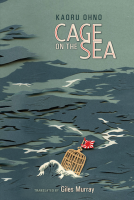![]() Author: Yu Godai
Author: Yu Godai
Translator: Kevin Frane
U.S. publisher: Bento Books
ISBN: 9781939326003
Released: July 2014
Original release: 2011
Quantum Devil Saga: Avatar Tuner, Volume 1, a novel written by Yu Godai, was originally published in Japan in 2011. The English-language edition of the volume, translated by Kevin Frane, was released in 2014 by Bento Books. It is the first book in a five-volume series which is further divided into three parts. (The first volume consists of the first half of the first part.) Those familiar with the video game series Digital Devil Saga: Avatar Tuner, a spinoff of the Shin Megami Tensei games, will find Quantum Devil Saga to be familiar as well. The series isn’t a novelization of the video games, but it is based on the same original story created by Godai which became the underlying framework for Digital Devil Saga. Although I was aware of Shin Megami Tensei, which has quite a following, and Digital Devil Saga specifically, I’ve never actually played any of the games myself. Even so, I was still very interested in reading Quantum Devil Saga, Godai’s first written work to appear in English.
The denizens of the Junkyard exist to die in battle only to be born again in a never-ending struggle to reach the promised paradise of Nirvana. The Junkyard is divided into seven territories, one held by the Church of the Arbiters of Karma while the other six are the domain of rival tribes of skilled fighters. Only when one group is able to obtain complete control of the entire Junkyard will the gates to Nirvana be opened. Serph is the leader of the Embryon, a small tribe that has quickly gained strength, numbers, and territory. During the Embryon’s confrontation with the Vanguards tribe, an unidentifiable device appears on the battlefield which dramatically changes the balance of power in the Junkyard, unleashing the combatants’ darker selves and transforming them into demons. Suddenly, the very laws that governed the world in which they live have changed. Established systems have begun to fracture, the cycle of reincarnation is interrupted, and the quest for Nirvana has become deadlier than ever.
Quantum Devil Saga isn’t a video game novelization, nor does it read like one. However, it is quite easy to see how the story and scenario could be suited for or smoothly adapted as a game. The narrative is fairly linear, generally following Serph’s point of view as he and his comrades strive to understand everything that has happened. The way that the transformations are handled and how skills and knowledge are gained in the novel could sometimes be reminiscent of game play or mechanics. The characters fight in a series of battles with increasingly high stakes and difficulty levels, ultimately ending with what cold be considered a boss battle. It’s clearly not the final boss, though, seeing as the first volume concludes with something of a cliffhanger. But none of these similarities are actually bad things and despite them Quantum Devil Saga doesn’t feel overly game-like. It is entirely its own work and exceptionally engaging one at that. The action is exciting and clear, the characters’ philosophical and psychological development is fascinating, and the translation is great, too. Once I started reading Quantum Devil Saga, I didn’t want to put it down.
What made Quantum Devil Saga particularly interesting and intriguing for me was its setting and atmosphere. The world-building of the series is heavily informed by Hindu and Buddhist cosmology and symbolism. (There is also at least one example of Mayan influence, but I found its inclusion to be rather strange given the context of the rest of the novel.) At first it seems as though these concepts are mostly used as a source of aesthetic inspiration, but they actually run fairly deep. However, readers don’t necessarily need to be acquainted with Hinduism or Buddhism to enjoy the story, although those who are will probably get even more out of an already great novel. The overall tone of Quantum Devil Saga is fairly dark. The demonic transformations that the characters are subject to have horrific and unsettling implications. Some of them wholeheartedly embrace their new powers and forms while others are desperate to hold on to the shreds of their humanity. They are forced to face their true selves and struggle with what they see. I enjoyed the first volume of Quantum Devil Saga immensely and can’t wait for the second volume to be released.
